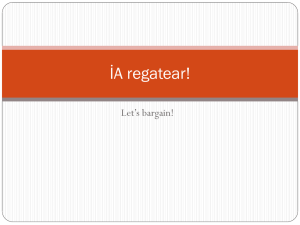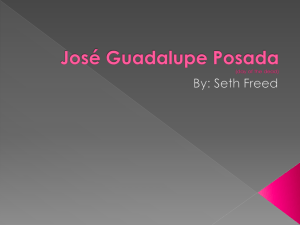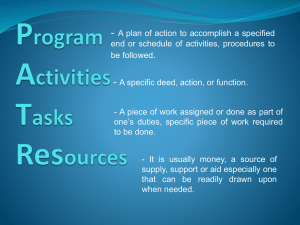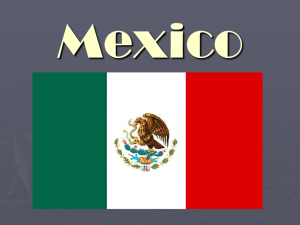Las Verduras
advertisement
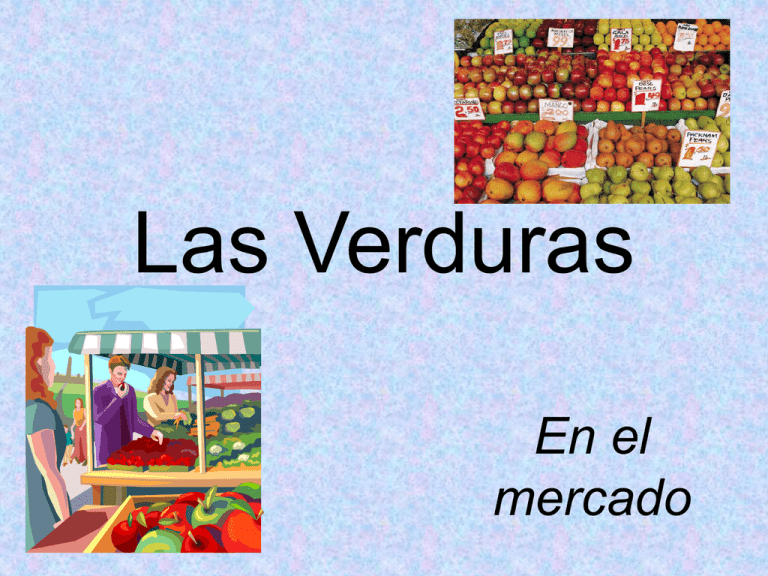
Las Verduras En el mercado Student Learning Outcome(s): At the end of this lesson, I can: YO PUEDO… • Select the appropriate vocabulary to identify vegetables in a Mexican Market Place. • Select the appropriate structures to maintain a conversation in a Mexican Market Place. • Select the appropriate formula to determine exchange rates in order to decide if an item is cheap or expensive. Student Learning Agenda At the end of this lesson, students should be able to: • Identify vegetables at a Market Place • Maintain a conversation using formulaic language between a client and salesperson at a Market Place • Demonstrate understanding of noun/adjective agreement and present tense conjugations • Convert pesos into US Dollars HAZLO AHORA DO IT NOW Knowledge you should bring to class: Students should come to class with the ability to do long division without a calculator. Demonstrate your ability to do this by solving these problems: 144/12 = 350/12= 565/12= Pre-Assessment of Today’s Lesson: Imagine you are a salesperson at a Mexican Market Place. What are you selling? How much does it cost? Can you create a short conversation that you would have with a client. VAMOS A REPASAR EL VOCABULARIO ¿Cuál verdura te gusta comer? Vamos a aprender el vocabulario importante para mantener una conversación en el mercado Las Personas en el Mercado Yo soy el vendedero. *If I was a girl, I would be – la vendedera. Yo soy el/la cliente. ¿Cuál verdura quiere comprar Ud.? Which vegetable do you want to buy? *Remember, I must be respectful to my cliente and ask questions using the Usted form. - Yo quiero comprar… Con un/una compañero(a)… With a partner take turns being the vendedero and the cliente. Find out what verduras the cliente wants to buy. Cliente 1 Cliente 2 ¿ Cuánto cuesta? How much does…cost? ¿Cuánto cuesta el maíz? ¿Cuánta cuesta la lechuga? ¿Cuántos cuestan los pepinos? ¿Cuántas cuestan las papas? *Remember that similar to an adjective, cuánto needs to agree (in number and in gender) with the noun that it is describing. *Another item to remember – COSTAR is an irregular verb. It has a stem-change. The O changes to UE in all forms but nosotros and vosotros. It is important that verbs are congjugated to match the subject. In this case, the subject is the vegetable. Use the “él/ella” form for singular nouns and the “ellos/ellas” form for plural nouns. CUESTA / CUESTAN …COSTS -El maíz cuesta treinta y seis pesos. -La lechuga cuesta veinte y cuatro pesos. -Los pepinos cuestan trescientos pesos. -Las papas cuestan doscientos cuarenta y uno pesos. EXCHANGE RATE 12 pesos mexicanos = $1.00 ¡Ay, que caro(a/os/as)! How expensive! ¡Ay, que barato(a/os/as)! How cheap! Con un/una compañero(a)… With a partner take turns being the vendedero and the cliente. Find out how much each (cada) verdura costs. Finally, using the exchange rate, decide if each verdura is expensive or cheap. Verdura Cuesta(n) Cliente 1 144 pesos Cliente 2 75 pesos VAMOS A PRACTICAR Actividad # 1 In a Mercado Mexicano Using your highest level of proficiency, try maintaining a conversation between a client and a salesperson in a Mexican Market Place. What vegetables does the client want, how much do they cost, and what are the clients thoughts about the price? Use the given rubric to assess the conversation that you and your partner have. Actividad Final Turn and Talk Can your partner… • Identify 5 vegetables? • Figure out how much 200 pesos is in US dollars? • Tell that something is cheap? • Ask a question being either the customer or salesperson in a Mexican Market Place? La Tarea • Study your vegetable vocabulary • Complete the Worksheet – En el mercado




